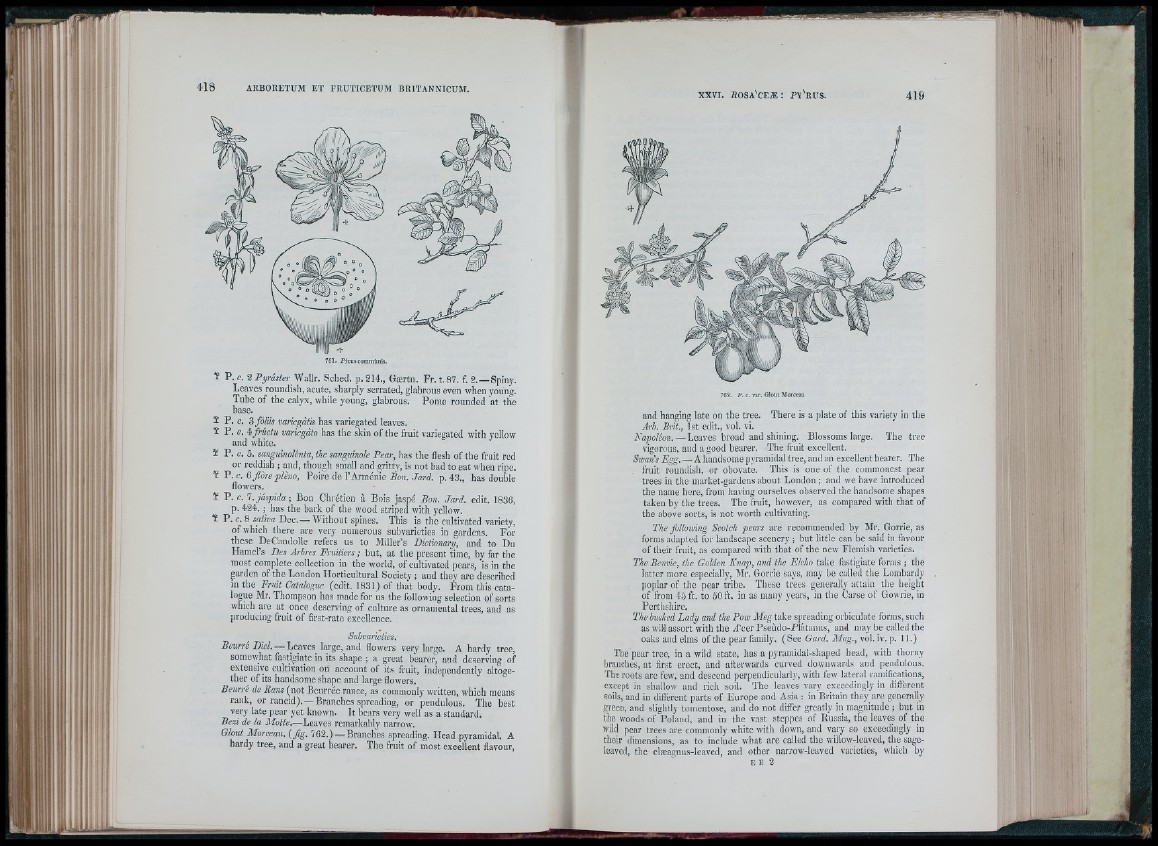
-lì
761. P J ru s commùnis.
¥ P . c. 2 Pyraster 'Wallr. Sched. p. 214., Gærtn. Fr. t. 87. f. 2.— Spiny.
Leaves roundish, acute, sharply serrated, glabrous even when young.
Tube of the calyx, while young, glabrous. Pome rounded at the
base.
¥ P . e. 3 foliis vaì'iegàtis has variegated leaves.
¥ P . e. A frúctu variegâta has the skin of the fruit variegated with yellow
and white.
¥ P. c. 5. sanguinolènta, the sangtdnole Pear, has the flesh of the fruit red
or reddish ; and, though small and gritty, is not bad to eat when ripe.
¥ V. c. 6 Jlòì-e pièno, Poire de l’Arménie rio » , ./arrf. p. 43., has double
flowers.
¥ P. c. T.jâspida-, Bon Chrétien à Bois jaspé Bon. Jard. edit. 1836,
p. 424. ; has the bark of the wood striped with yellow.
¥ V .c . 8 sativa Gee. — Vfithout spines. This is the cultivated variety,
of which there are very numerous subvarieties in gardens. For
these DeCandolle refers us to Miller’s Dictionary, and to Du
Hamel’s Des Arbres Fruitiers ; but, at the present time, by far the
most complete collection in the world, of cultivated pears, is in the
garden of the London Horticultural Society ; and they are described
in the Frtiit Catalogue (edit. 1831) of that body. From this catalogue
Mr. Thompson has made for us the following selection of sorts
which arc at once deserving of culture as ornamental trees, and as
producing fruit of first-rate excellence.
Subvarieties.
Beurré Diel. — Leaves large, and flowers very large. A hardy tree,
somewhat fastigiate in its shape ; a great bearer, and deserving of
extensive cultivation on account of its fruit, independently altogether
of its handsome shape and large flowers.
Beurré de Bans (not Beurrée rance, as commonly written, which means
rank, or rancid). — Branches spreading, or pendulous. The best
very late pear yet known. I t bears very well as a standard.
Bezi de la Motte.—Leaves remarkably narrow.
Glout Morceau, { f ig. 7 6 2 .)— Branches spreading. Head pyramidal. A
hardy tree, and a great bearer. The fruit of most excellent flavour.
762. P. c. var. Glout Morceau
and hanging late on the tree. There is a plate of this variety in the
Arb. Brit., 1st edit., vol. vi.
Kapolbon. — Leaves broad and shining. Blossoms large. The tree
vigorous, and a good bearer. The fruit excellent.
Swan's Egg. — A handsome pyramidal tree, and an excellent bearer. Tbe
fruit roundish, or obovate. This is one of the commonest pear
trees in the market-gardens about London ; and we have introduced
the name here, from having ourselves observed the handsome shapes
taken by the trees. The fVuit, however, as compared with that of
the above sorts, is not worth cultivating.
The Jhlloiving Scotch pears are recommended by Mr. Gorrie, as
forms adapted for landscape scenery ; but little can be said in favour
of their fruit, as compared with that of the new Flemish varieties»
The Benvie, the Golden Knap, and the Elcho take fastigiate forms ; tbe
latter more especially, Mr. Gorrie says, may be called the Lombardy
poplar of the pear tribe. These trees generally attain tlie height
of from 45 ft. to 50 ft. in as many years, in the Carse o f Gowrie, in
Pertlishire.
The busked Lady and the Pow Meg take spreading orbiculate forms, such
as wiR assort with the A'cer Pseudo-Platanus, and may be called the
oaks and elms of the pear family. (See Gard. Mag., vol.iv. p. 11.)
The pear tj-ee, in a wild state, has a pyramidal-shaped head, with thorny
branches, at first erect, and afterwards curved downwards and pendulous.
The roots are few, and descend perpendicularly, with few lateral ramifications,
except in shallow and rich soil. The leaves vary exceedingly in different
soils, and in different parts of Europe and Asia t in Britam they are generally
green, and slightly tomentose, and do not differ greatly in magnitude ; but in
the woods of Poland, and ' the ’ vast steppes of Russia, the *leaves of -r .the
i--
wild pear trees
are commmoonnlly white with down, and vary so exceedingly in
their \limensions, as to include what are called the willow-leaved, the sageleaved,
the el8eagnu.s-Ieaved, and other narrow-leaved varieties, which by
E E 2